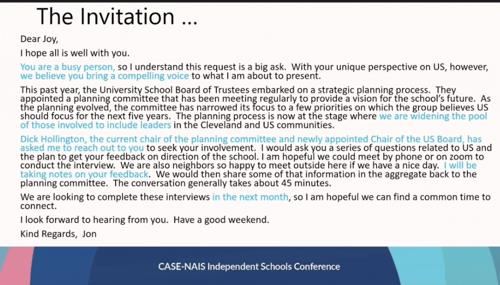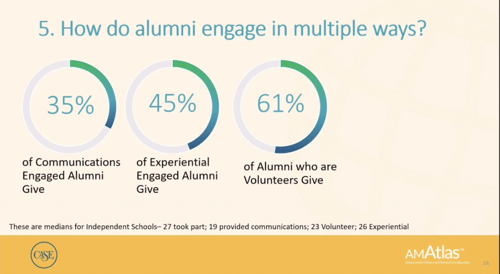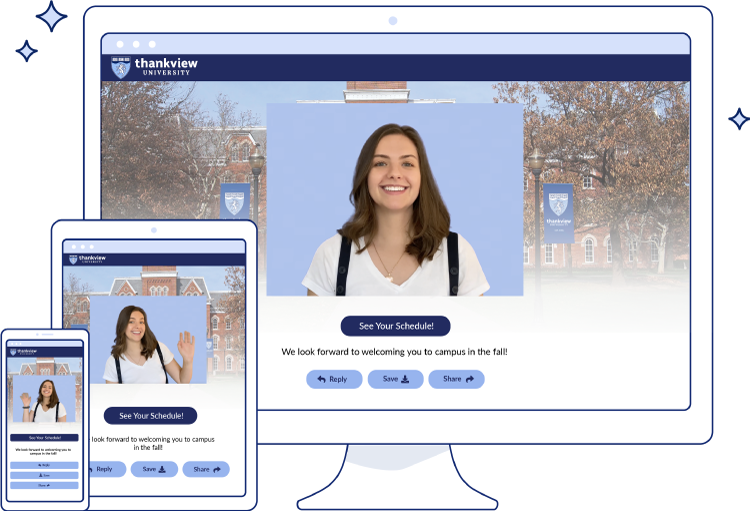Key Takeaways from CASE-NAIS
Our team had a fantastic time at the CASE-NAIS conference! There were many great speakers and sessions, but here are the highlights from just a few of those we attended.
Storytelling and Community Building in a Virtual World
Marion Couzens, Director of Institutional Advancement, and Katherine Murphy, Donor Relations and Reunion Coordinator, Foxcroft School
Initially, during the pandemic, the Foxcroft School was hesitant in reaching out to people. However, they quickly realized they needed to share their stories with their donors to connect them to the institution and how they were still supporting their stakeholders and mission. They needed to give the community an opportunity to engage.
They realized that video was a channel they could leverage to effectively tell their story. They built a “quilt” of stories on their website, creating a library of webpages and videos presented in an organized manner. They then invited stakeholders to share their stories via social media and email. This format gave them the flexibility to repurpose the structure as people engaged in passion areas, add new stories easily, and continue to provide updates through COVID.
It also accomplished the goal of allowing them to talk about giving. Once you bring the community together, remind everyone that you are just that… a community! One that needs to be there for each other.
The most important areas to focus on when building this strategy are:
- Branding consistency to make sure each piece represents the whole
- A unified schedule – Make sure you include when you will request new stories and content, when your communications will go out (including follow-up emails), when you will share on social, etc.
- Segmented lists of potential recipients – don’t forget to include internal stakeholders such as students and teachers in addition to alumni and parents
7 Keys To Fundraising Success
Stephen Sturman, Director of Institutional Advancement, The Orchard School
These fundamentals all depend on one simple task: do your research! Never come to a donor meeting unprepared, or without at least 3-5 ways to combat a no answer. Know your donor’s background, their accomplishments, their net worth, past contributions, etc.
Here are the seven fundamentals you can apply within that context:
- Kindness → Charity → Cultivation. More touches are better but always treat your donors with the utmost respect and kindness.
- Action → Diligence → Take Responsibility. Be on time. When you first arrive at the meeting, turn your phone off and put it away. Give the donor your full attention. If you don’t think you’ll be able to give your full attention, reschedule the meeting. Take notes and listen intently and attentively.
- Mindfulness → Patience → Stay in the Moment. Stay in the present, don’t dwell on the past! Magnificent gifts are seldom the result of magnificent asks.
- Visualize Success → Courage → Confident Solicitation. Remember that you are making the world better one gift at a time. Your job is important and you are good at it. Talk with purpose and confidence, but never cockiness.
- Sincerity → Honor → Be Yourself. Believe in yourself and BE YOURSELF. Believe in your institution as well.
- Gratitude → Kindness → Stewardship. “Feeling gratitude and not expressing it is like wrapping a present and not giving it.” Your best stewardship will lead to even larger gifts.
- The Advancement process: Discovery → Cultivation → Solicitation →Stewardship. All of these should be equally weighted.
How a Content Strategy Can Help During Times of Calm and Times of COVID
Terry Dubow, Director of Special Projects, Hawken School
Why do families choose independent schools? Parents hire schools to do a job. They expect certain things from independent schools, and at the top of that list is meeting some minimum requirement of rigorous academia. However, there are also psychological and emotional needs. When people buy things they are often not doing it rationally; the products we buy speak to some irrational need.
Realizing these two facets, Hawken’s Mastery School deployed an audience-calibrated, market-aware, problem-based, and solution-focused messaging platform that responds to audiences’ anxieties and worries. Their Marketing objective was to establish HMS as a logical and pragmatic solution to visceral and vital problems.
To accomplish this, they focused their Marketing strategy on digital channels.
- They invested in video, which was a crucial element in sharing the idea behind the Mastery School. They created multiple ads featuring students, teachers, staff, and faculty and ran them during movie previews at local movie theaters.
- They also utilized podcasts as a way to take people through the new operations of online learning, not necessarily focused directly on Hawken, but woven through.
- They also leveraged TV, creating a show that addresses topics they are hearing in the community. For example, there were some concerns regarding math and remote learning, so they brought in the math teachers and had them explain. They could then share that video on social media and send it to parents, alumni, etc.
The Role of Questioning & Listening in Major Gift Engagement
Jonathan Bridge, Assistant Head of School for Advancement, University School
This session primarily discussed the questioning and listening methods for donors leading to higher engagement rates. The key theme through all of this was to reach out to donors in an authentic and meaningful manner, the video being an optimal vehicle to drive this connection. The following were key points:
- Using the school’s students in an engagement piece shows where the donations are going and how it’s helping them.
- Showcasing how much and how many times people donated displays transparency and allows the donors to see their dollars at work.
- Asking questions to donors intentionally makes them feel appreciated and includes them in the conversation.
- An email followed by a phone call is the best way to approach donors (email template attached below) as you always want to acknowledge they’re busy.
- Authentic engagement precedes philanthropy, emotion drives the decision, and questions unearth the subconscious.

AMAtlas: Enabling Data-Driven Strategies for Fundraising and Engagement
David Bass, Senior Director of Research, CASE; Jenny Cooke Smith, Sr. Strategic Consultant, AMAtlas, CASE; and Cindy Shaw, Director of The Haverford Fund, The Haverford School
The Haverford School used AMAtlas to gauge their engagement pre-covid and now. Their framework measures engagement through volunteering, communication, philanthropic metrics, and experimental data (such as downloads of the school’s podcast, reports, and magazine).
What they learned is that philanthropy is only part of the larger story – 40% to be exact! As data collection is refined, there’s an opportunity to learn about the relationship between giving and other forms of engagement. The important piece to consider is utilizing global standards and core metrics. These are tools that are going to help enable the quality of data when dealing with the relationship between fundraising and engagement.

The Unsexy Truth of Successful Branding— Alumni Office
Shane Shanks, Senior Communications Strategist and Editorial Director, Zehno; and Christy Zurcher, Director of Communications, Ursuline Academy of New Orleans
Be present.
- Greet students and parents upon arrival to school, events, and games
- Be recognizable on campus
- Familiarize yourself with the parents of students
Be a destination.
- Be a drop off/pick up spot
- Be a place where students feel comfortable to congregate
- It’s important to be a reprieve from academics as well as a place to engage with them
Be seen.
- Go to different events
- Make sure to be active at games, concerts, and other types of events
- Stop into classrooms
Make sure to engage your primary audiences.
- Students
- Alumni week – Invite alumni to visit and talk about their work and use this as an opportunity to educate students on alumni and alumni programs. Make it fun and interactive by hosting rallies and panels.
- Parents
- Actively reach out to parents and keep them updated on current events at the school via update emails, videos, and direct mail.
- Alumni
- The majority are out of state and aren’t able to attend events physically — it’s important to keep them engaged by getting geographically creative. Have different alumni fly in to speak to students about their profession and make sure parents are invited. Host events on campus that allow alumni to speak to the student body, individuals, and specific grades about their profession and path. Alternatively, host online seminars where alumni can advise current students and answer questions.
- Try also hosting events in different cities where many alumni reside (ex. Chicago) — you can host a happy hour or dinner for alumni to try to establish networking opportunities.
Be Done with your Annual Fund in Only 4 Weeks
Meade Davis, Director of Advancement Outreach, Randolph School, and Jill Gaunt, Director of Annual Giving and Alumni Relations, Randolph School
The main takeaway from this session was to keep donors engaged throughout the year. Do not pop onto their radar once a year to ask for a gift. Alumni are most likely to be generous when they feel that they are still actively engaged with the community and have a voice.
- It’s important to identify major donors months in advance and actively reach out.
- Keep donors engaged throughout the year so that they are not surprised when solicited for funds.
- An Annual Fund request should not come as a surprise — donors should be contacted and updated on current events year-round. They should feel like they are still a part of the community
Techniques
- Personalization is key for major donors.
- Showing appreciation leads to reoccurring generosity.
- Allow alumni to be active on campus- if they have a voice they are more likely to be involved.
